On a Hawaiian mountaintop in the summer of 1992, a pair of scientists spotted a pinprick of light inching through the constellation Pisces. That unassuming object — located over a billion kilometers beyond Neptune — would rewrite our understanding of the solar system.
Rather than an expanse of emptiness, there was something, a vast collection of things in fact, lurking beyond the orbits of the known planets.
The scientists had discovered the Kuiper Belt, a doughnut-shaped swath of frozen objects left over from the formation of the solar system.
As researchers learn more about the Kuiper Belt, the origin and evolution of our solar system is coming into clearer focus. Closeup glimpses of the Kuiper Belt’s frozen worlds have shed light on how planets, including our own, might have formed in the first place. And surveys of this region, which have collectively revealed thousands of such bodies, called Kuiper Belt objects, suggest that the early solar system was home to pinballing planets.
The humble object that kick-started it all is a chunk of ice and rock roughly 250 kilometers in diameter. It was first spotted 30 years ago this month.

Sign Up For the Latest from Science News
Headlines and summaries of the latest Science News articles, delivered to your inbox
Client key* E-mail Address* Go
Thank you for signing up!
There was a problem signing you up.
Staring into space
In the late 1980s, planetary scientist David Jewitt and astronomer Jane Luu, both at MIT at the time, were several years into a curious quest. The duo had been using telescopes in Arizona to take images of patches of the night sky with no particular target in mind. “We were literally just staring off into space looking for something,” says Jewitt, now at UCLA.
An apparent mystery motivated the researchers: The inner solar system is relatively crowded with rocky planets, asteroids and comets, but there was seemingly not much out beyond the gas giant planets, besides small, icy Pluto. “Maybe there were things in the outer solar system,” says Luu, who now works at the University of Oslo and Boston University. “It seemed like a worthwhile thing to check out.”
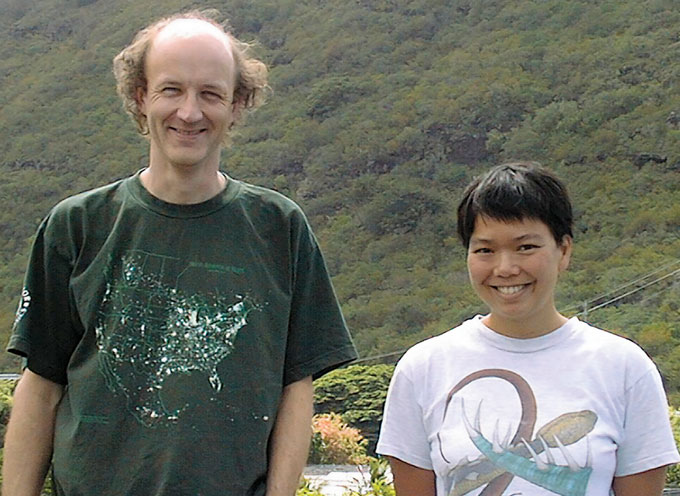 David Jewitt and Jane Luu, shown in Honolulu in the early 2000s, discovered the Kuiper Belt.D. Jewitt/UCLA
David Jewitt and Jane Luu, shown in Honolulu in the early 2000s, discovered the Kuiper Belt.D. Jewitt/UCLA
Poring over glass photographic plates and digital images of the night sky, Jewitt and Luu looked for objects that moved extremely slowly, a telltale sign of their great distance from Earth. But the pair kept coming up empty. “Years went by, and we didn’t see anything,” Luu says. “There was no guarantee this was going to work out.”
The tide changed in 1992. On the night of August 30, Jewitt and Luu were using a University of Hawaii telescope on the Big Island. They were employing their usual technique for searching for distant objects: Take an image of the night sky, wait an hour or so, take another image of the same patch of sky, and repeat. An object in the outer reaches of the solar system would shift position ever so slightly from one image to the next, primarily because of the movement of Earth in its orbit. “If it’s a real object, it would move systematically at some predicted rate,” Luu says.
By 9:14 p.m. that evening, Jewitt and Luu had collected two images of the same bit of the constellation Pisces. The researchers displayed the images on the bulbous cathode-ray tube monitor of their computer, one after the other, and looked for anything that had moved. One object immediately stood out: A speck of light had shifted just a touch to the west.
But it was too early to celebrate. Spurious signals from high-energy particles zipping through space — cosmic rays — appear in images of the night sky all of the time. The real test would be whether this speck showed up in more than two images, the researchers knew.
Jewitt and Luu nervously waited until 11 p.m. for the telescope’s camera to finish taking a third image. The same object was there, and it had moved a bit farther west. A fourth image, collected just after midnight, revealed the object had shifted position yet again. This is something real, Jewitt remembers thinking. “We were just blown away.”
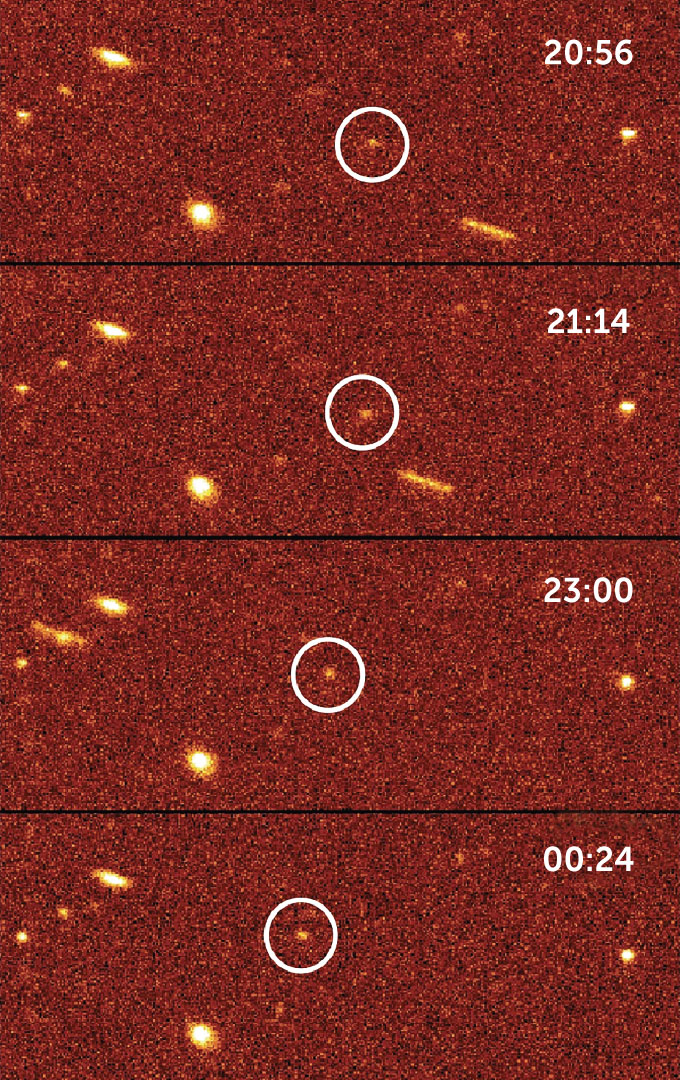 The way the circled object shifted position in the sky (time stamps at right) told Jewitt and Luu that the object, dubbed 1992 QB1, was distant. It was the first evidence of the icy zone called the Kuiper Belt.D. Jewitt/UCLA
The way the circled object shifted position in the sky (time stamps at right) told Jewitt and Luu that the object, dubbed 1992 QB1, was distant. It was the first evidence of the icy zone called the Kuiper Belt.D. Jewitt/UCLA
Based on the object’s brightness and its leisurely pace — it would take nearly a month for it to march across the width of the full moon as seen from Earth — Jewitt and Luu did some quick calculations. This thing, whatever it was, was probably about 250 kilometers in diameter. That’s sizable, about one-tenth the width of Pluto. It was orbiting far beyond Neptune. And in all likelihood, it wasn’t alone.
Although Jewitt and Luu had been diligently combing the night sky for years, they had observed only a tiny fraction of it. There were possibly thousands more objects out there like this one just waiting to be found, the two concluded.
The realization that the outer solar system was probably teeming with undiscovered bodies was mind-blowing, Jewitt says. “We expanded the known volume of the solar system enormously.” The object that Jewitt and Luu had found, 1992 QB1 (SN: 9/26/92, p. 196), introduced a whole new realm.
Just a few months later, Jewitt and Luu spotted a second object also orbiting far beyond Neptune (SN: 4/10/93, p. 231). The floodgates opened soon after. “We found 40 or 50 in the next few years,” Jewitt says. As the digital detectors that astronomers used to capture images grew in size and sensitivity, researchers began uncovering droves of additional objects. “So many interesting worlds with interesting stories,” says Mike Brown, an astronomer at Caltech who studies Kuiper Belt objects.
Finding all of these frozen worlds, some orbiting even beyond Pluto, made sense in some ways, Jewitt and Luu realized. Pluto had always been an oddball; it’s a cosmic runt (smaller than Earth’s moon) and looks nothing like its gas giant neighbors. What’s more, its orbit takes it sweeping far above and below the orbits of the other planets. Maybe Pluto belonged not to the world of the planets but to the realm of whatever lay beyond, Jewitt and Luu hypothesized. “We suddenly understood why Pluto was such a weird planet,” Jewitt says. “It’s just one object, maybe the biggest, in a set of bodies that we just stumbled across.” Pluto probably wouldn’t be a member of the planet club much longer, the two predicted. Indeed, by 2006, it was out (SN: 9/2/06, p. 149).
Up-close look
The discovery of 1992 QB1 opened the world’s eyes to the Kuiper Belt, named after Dutch-American astronomer Gerard Kuiper. In a twist of history, however, Kuiper predicted that this region of space would be empty. In the 1950s, he proposed that any occupants that might have once existed there would have been banished by gravity to even more distant reaches of the solar system.
In other words, Kuiper anti-predicted the existence of the Kuiper Belt. He turned out to be wrong.
Today, researchers know that the Kuiper Belt stretches from a distance of roughly 30 astronomical units from the sun — around the orbit of Neptune — to roughly 55 astronomical units. It resembles a puffed-up disk, Jewitt says. “Superficially, it looks like a fat doughnut.”
The frozen bodies that populate the Kuiper Belt are the remnants of the swirling maelstrom of gas and dust that birthed the sun and the planets. There’s “a bunch of stuff that’s left over that didn’t quite get built up into planets,” says astronomer Meredith MacGregor of the University of Colorado Boulder. When one of those cosmic leftovers gets kicked into the inner solar system by a gravitational shove from a planet like Neptune and approaches the sun, it turns into an object we recognize as a comet (SN: 9/12/20, p. 14). Comets that circle the sun once only every 200 years or more typically derive from the solar system’s even more distant repository of icy bodies known as the Oort cloud.
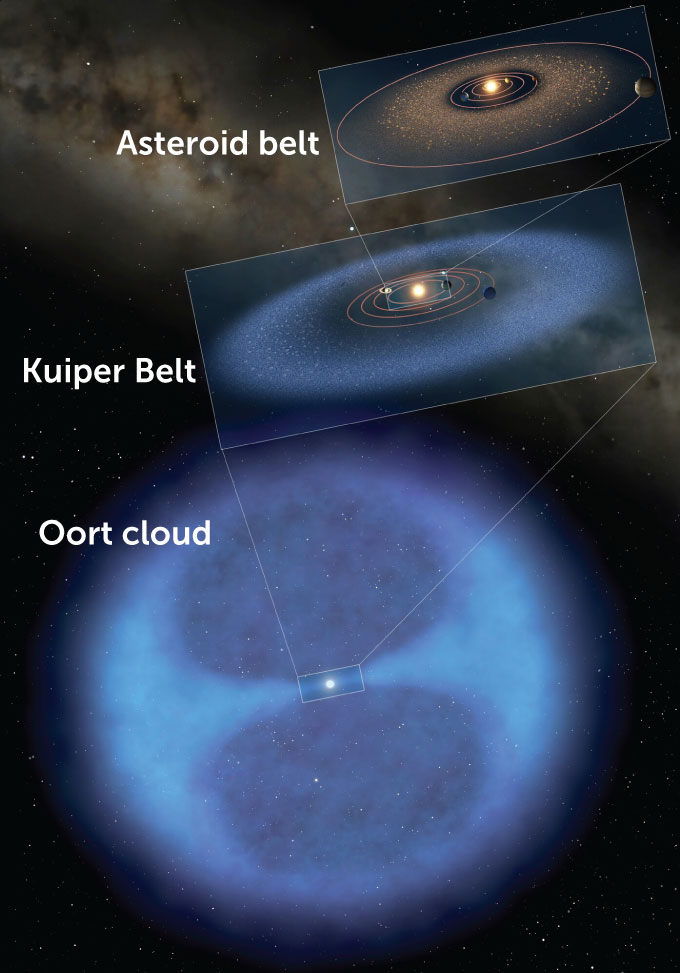 There are many places in the solar system where icy bodies congregate: the asteroid belt roughly between Jupiter and Mars (top), the doughnut-shaped Kuiper Belt beyond the gas giant planets (middle) and the most distant zone, the Oort cloud (bottom).Mark Garlick/Science Source
There are many places in the solar system where icy bodies congregate: the asteroid belt roughly between Jupiter and Mars (top), the doughnut-shaped Kuiper Belt beyond the gas giant planets (middle) and the most distant zone, the Oort cloud (bottom).Mark Garlick/Science Source
In scientific parlance, the Kuiper Belt is a debris disk (SN Online: 7/28/21). Distant solar systems contain debris disks, too, scientists have discovered. “They’re absolutely directly analogous to our Kuiper Belt,” MacGregor says.
In 2015, scientists got their first close look at a Kuiper Belt object when NASA’s New Horizons spacecraft flew by Pluto (SN Online: 7/15/15). The pictures that New Horizons returned in the following years were thousands of times more detailed than previous observations of Pluto and its moons. No longer just a few fuzzy pixels, the worlds were revealed as rich landscapes of ice-spewing volcanoes and deep, jagged canyons (SN: 6/22/19, p. 12; SN Online: 7/13/18). “I’m just absolutely ecstatic with what we accomplished at Pluto,” says Marc Buie, an astronomer at the Southwest Research Institute in Boulder, Colo., and a member of the New Horizons team. “It could not possibly have gone any better.”
But New Horizons wasn’t finished with the Kuiper Belt. On New Year’s Day of 2019, when the spacecraft was almost 1.5 billion kilometers beyond Pluto’s orbit, it flew past another Kuiper Belt object. And what a surprise it was. Arrokoth — its name refers to “sky” in the Powhatan/Algonquian language — looks like a pair of pancakes joined at the hip (SN: 12/21/19 & 1/4/20, p. 5; SN: 3/16/19, p. 15). Roughly 35 kilometers long from end to end, it was probably once two separate bodies that gently collided and stuck. Arrokoth’s bizarre structure sheds light on a fundamental question in astronomy: How do gas and dust clump together and grow into larger bodies?
One long-standing theory, called planetesimal accretion, says that a series of collisions is responsible. Tiny bits of material collide and stick together on repeat to build up larger and larger objects, says JJ Kavelaars, an astronomer at the University of Victoria and the National Research Council of Canada. But there’s a problem, Kavelaars says.
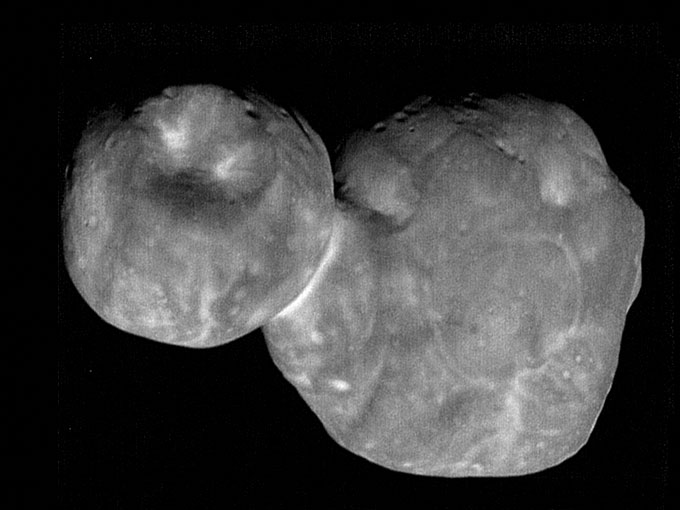 In 2019, New Horizons flew by Arrokoth (above), a roughly 35-kilometer-long Kuiper Belt object.NASA, JHU-APL, SWRI
In 2019, New Horizons flew by Arrokoth (above), a roughly 35-kilometer-long Kuiper Belt object.NASA, JHU-APL, SWRI
As objects get large enough to exert a significant gravitational pull, they accelerate as they approach one another. “They hit each other too fast, and they don’t stick together,” he says. It would be unusual for a large object like Arrokoth, particularly with its two-lobed structure, to have formed from a sequence of collisions.
More likely, Arrokoth was born from a process known as gravitational instability, researchers now believe. In that scenario, a clump of material that happens to be denser than its surroundings grows by pulling in gas and dust. This process can form planets on timescales of thousands of years, rather than the millions of years required for planetesimal accretion. “The timescale for planet formation completely changes,” Kavelaars says.
If Arrokoth formed this way, other bodies in the solar system probably did too. That may mean that parts of the solar system formed much more rapidly than previously believed, says Buie, who discovered Arrokoth in 2014. “Already Arrokoth has rewritten the textbooks on how solar system formation works.”
What they’ve seen so far makes scientists even more eager to study another Kuiper Belt object up close. New Horizons is still making its way through the Kuiper Belt, but time is running out to identify a new object and orchestrate a rendezvous. The spacecraft, which is currently 53 astronomical units from the sun, is approaching the Kuiper Belt’s outer edge. Several teams of astronomers are using telescopes around the world to search for new Kuiper Belt objects that would make a close pass to New Horizons. “We are definitely looking,” Buie says. “We would like nothing better than to fly by another object.”
All eyes on the Kuiper Belt
Astronomers are also getting a wide-angle view of the Kuiper Belt by surveying it with some of Earth’s largest telescopes. At the Canada-France-Hawaii Telescope on Mauna Kea — the same mountaintop where Jewitt and Luu spotted 1992 QB1 — astronomers recently wrapped up the Outer Solar System Origins Survey. It recorded more than 800 previously unknown Kuiper Belt objects, bringing the total number known to roughly 3,000.
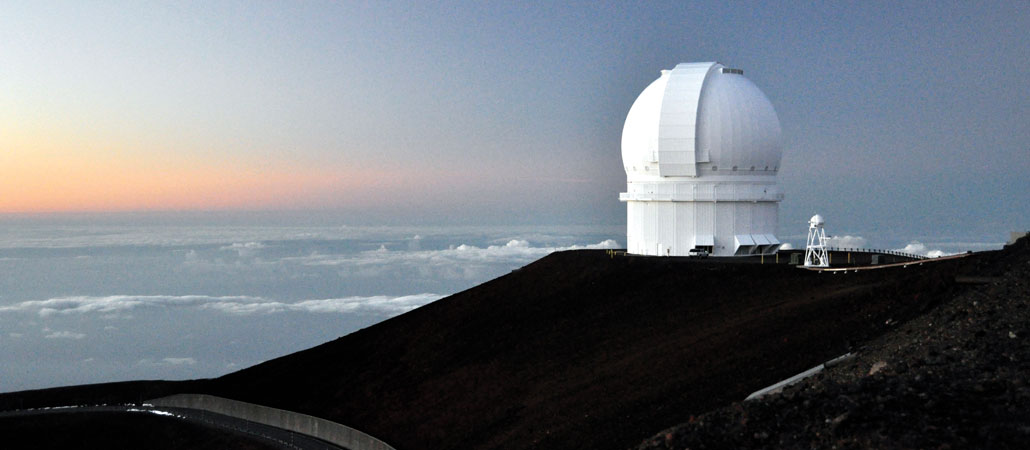 The Canada-France-Hawaii Telescope, near the summit of Mauna Kea on Hawaii’s Big Island, has revealed hundreds of Kuiper Belt objects.Gordon W. Myers/Wikimedia Commons (CC BY-SA 4.0)
The Canada-France-Hawaii Telescope, near the summit of Mauna Kea on Hawaii’s Big Island, has revealed hundreds of Kuiper Belt objects.Gordon W. Myers/Wikimedia Commons (CC BY-SA 4.0)
This cataloging work is revealing tantalizing patterns in how these bodies move around the sun, MacGregor says. Rather than being uniformly distributed, the orbits of Kuiper Belt objects tend to be clustered in space. That’s a telltale sign that these bodies got a gravitational shove in the past, she says.
The cosmic bullies that did that shoving, most astronomers believe, were none other than the solar system’s gas giants. In the mid-2000s, scientists first proposed that planets like Neptune and Saturn probably pinballed toward and away from the sun early in the solar system’s history (SN: 5/5/12, p. 24). That movement explains the strikingly similar orbits of many Kuiper Belt objects, MacGregor says. “The giant planets stirred up all of the stuff in the outer part of the solar system.”
Refining the solar system’s early history requires observations of even more Kuiper Belt objects, says Meg Schwamb, an astronomer at Queen’s University Belfast in Northern Ireland. Researchers expect that a new astronomical survey, slated to begin next year, will find roughly 40,000 more Kuiper Belt objects. The Vera C. Rubin Observatory, being built in north-central Chile, will use its 3,200-megapixel camera to repeatedly photograph the entire Southern Hemisphere sky every few nights for 10 years. That undertaking, the Legacy Survey of Space and Time, or LSST, will revolutionize our understanding of how the early solar system evolved, says Schwamb, a cochair of the LSST Solar System Science Collaboration.
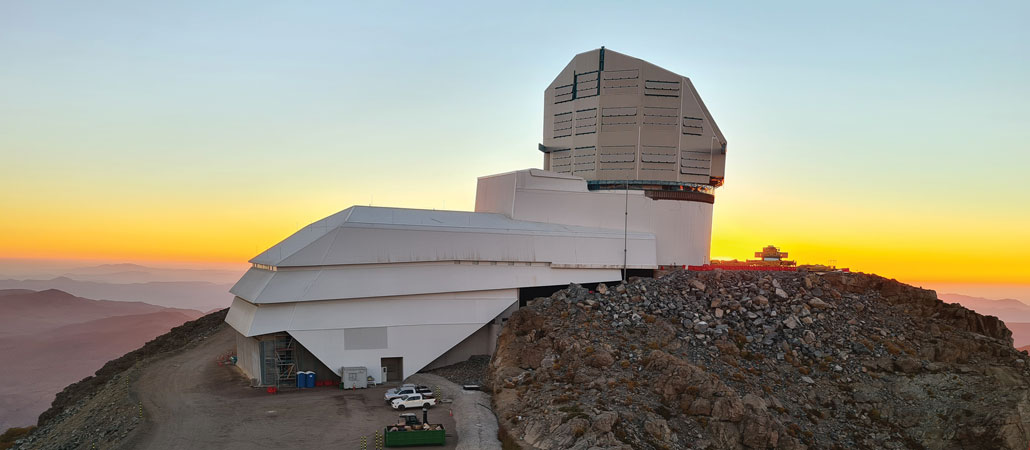 The Vera C. Rubin Observatory in Chile is expected to spot about 40,000 Kuiper Belt objects with its 8.4-meter mirror and the world’s largest digital camera.Rubin Observatory/NSF and AURA
The Vera C. Rubin Observatory in Chile is expected to spot about 40,000 Kuiper Belt objects with its 8.4-meter mirror and the world’s largest digital camera.Rubin Observatory/NSF and AURA
It’s exciting to think about what we might learn next from the Kuiper Belt, Jewitt says. The discoveries that lay ahead will be possible, in large part, because of advances in technology, he says. “One picture with one of the modern survey cameras is roughly a thousand pictures with our setup back in 1992.”
But even as we uncover more about this distant realm of the solar system, a bit of awe should always remain, Jewitt says. “It’s the largest piece of the solar system that we’ve yet observed.”

